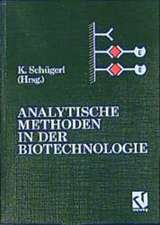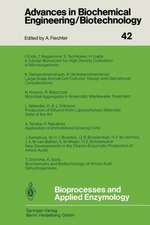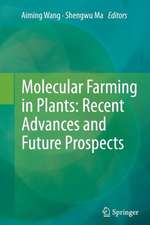Gene Expression Systems in Fungi: Advancements and Applications: Fungal Biology
Editat de Monika Schmoll, Christoph Dattenböcken Limba Engleză Hardback – 11 apr 2016
| Toate formatele și edițiile | Preț | Express |
|---|---|---|
| Paperback (1) | 651.34 lei 6-8 săpt. | |
| Springer International Publishing – 25 apr 2018 | 651.34 lei 6-8 săpt. | |
| Hardback (1) | 657.57 lei 6-8 săpt. | |
| Springer International Publishing – 11 apr 2016 | 657.57 lei 6-8 săpt. |
Din seria Fungal Biology
- 18%
 Preț: 1122.72 lei
Preț: 1122.72 lei - 15%
 Preț: 658.22 lei
Preț: 658.22 lei - 18%
 Preț: 1110.72 lei
Preț: 1110.72 lei - 20%
 Preț: 544.50 lei
Preț: 544.50 lei - 18%
 Preț: 948.61 lei
Preț: 948.61 lei - 18%
 Preț: 960.42 lei
Preț: 960.42 lei - 24%
 Preț: 1074.50 lei
Preț: 1074.50 lei - 18%
 Preț: 1228.96 lei
Preț: 1228.96 lei - 15%
 Preț: 635.01 lei
Preț: 635.01 lei - 18%
 Preț: 1403.98 lei
Preț: 1403.98 lei - 18%
 Preț: 1117.99 lei
Preț: 1117.99 lei - 18%
 Preț: 958.88 lei
Preț: 958.88 lei - 18%
 Preț: 951.77 lei
Preț: 951.77 lei - 18%
 Preț: 957.75 lei
Preț: 957.75 lei - 18%
 Preț: 1112.15 lei
Preț: 1112.15 lei - 18%
 Preț: 998.34 lei
Preț: 998.34 lei - 18%
 Preț: 954.93 lei
Preț: 954.93 lei - 18%
 Preț: 1117.99 lei
Preț: 1117.99 lei - 18%
 Preț: 1120.18 lei
Preț: 1120.18 lei - 15%
 Preț: 643.34 lei
Preț: 643.34 lei - 15%
 Preț: 640.71 lei
Preț: 640.71 lei - 18%
 Preț: 951.14 lei
Preț: 951.14 lei - 18%
 Preț: 948.92 lei
Preț: 948.92 lei - 15%
 Preț: 644.95 lei
Preț: 644.95 lei - 18%
 Preț: 1844.67 lei
Preț: 1844.67 lei - 18%
 Preț: 947.67 lei
Preț: 947.67 lei - 18%
 Preț: 1111.67 lei
Preț: 1111.67 lei - 18%
 Preț: 1010.65 lei
Preț: 1010.65 lei - 18%
 Preț: 953.35 lei
Preț: 953.35 lei - 18%
 Preț: 959.19 lei
Preț: 959.19 lei - 15%
 Preț: 645.28 lei
Preț: 645.28 lei
Preț: 657.57 lei
Preț vechi: 773.62 lei
-15% Nou
Puncte Express: 986
Preț estimativ în valută:
125.84€ • 130.90$ • 103.89£
125.84€ • 130.90$ • 103.89£
Carte tipărită la comandă
Livrare economică 14-28 aprilie
Preluare comenzi: 021 569.72.76
Specificații
ISBN-13: 9783319279497
ISBN-10: 3319279491
Pagini: 499
Ilustrații: XV, 499 p. 38 illus., 19 illus. in color.
Dimensiuni: 155 x 235 x 29 mm
Greutate: 0.89 kg
Ediția:1st ed. 2016
Editura: Springer International Publishing
Colecția Springer
Seria Fungal Biology
Locul publicării:Cham, Switzerland
ISBN-10: 3319279491
Pagini: 499
Ilustrații: XV, 499 p. 38 illus., 19 illus. in color.
Dimensiuni: 155 x 235 x 29 mm
Greutate: 0.89 kg
Ediția:1st ed. 2016
Editura: Springer International Publishing
Colecția Springer
Seria Fungal Biology
Locul publicării:Cham, Switzerland
Public țintă
ResearchCuprins
Gene expression by yeasts versus filamentous fungi – perspectives and challenges.- Ascomycetes as fungal workhorses for industry.- Industrial uses of Zygomycetes.- Biotechnological application of basidiomycetes.- Mining fungal genomes for improvement of gene expression.- Targets of strain improvement in fungi.- Sexual development for strain improvement of fungi.- Using chromatin modification in biotechnology.- Awakening silent clusters for expression secondary metabolites.- High throughput construction of genetically modified fungi.- Regulatory mechanisms in enzyme production by fungi.- Regulatory mechanisms in production of metabolites by fungi.- Production of enzymes and performance proteins in Trichoderma reesei.- Aspergilli – versatile producers of proteins and metabolites.- Fungal gene expression systems for antibiotics production.- Novel fungal gene expression systems for the future of biotechnology.- Designing the ideal production host – strategies and challenges in strain improvement.- Challenges and perspectives in expression of enzymes and performance proteins.- Exploiting natural selection – are novel fungal isolates the future of industrial biotechnology?.- Targeted genetic modification of organisms versus random mutagenesis – will societal acceptance influence industrial strategies?.
Recenzii
Notă biografică
Dr. Monika Schmoll received her degree and Ph. D. on the topic of “Regulation of cellulase expression and signal transduction in the filamentous fungus Hypocrea jecorina (Trichoderma reesei)” at the Vienna University of Technology, Austria. Besides gaining postdoctoral experience and building her own group at the Vienna University of Technology, she has been a visiting scientist in the laboratory of Professor N. Louise Glass (Department of Plant and Microbial Biology, University of California, Berkeley, USA), the University of Rome La Sapienza and the University of Szeged, Hungary. In 2012, Dr. Schmoll moved to the Austrian Institute of Technology (AIT) in Tulln, Austria, where she is now group leader and senior scientist. In march 2013 she completed her habilitation at the Vienna University of Technology in the field of “Molecular Genetics and Genomics”.
The primary research field of Dr. Schmoll is the interconnection between light response, sexual development and metabolism, with an emphasis on effects on cellulase gene expression in the filamentous fungus Trichoderma reesei. She showed for the first time that cellulase gene expression is modulated by light in T. reesei and could since then elucidate important mechanistic details on the underlying mechanism. Her group discovered the sexual cycle in the biotechnological workhorseTrichoderma, which had previously been considered asexual. Recently, her group also showed that communication upon sexual development is mediated by regulation of secondary metabolism. Her work with Trichoderma is complemented by contributions to genome annotation of several fungi (Trichoderma spp., Aspergillus nidulans, Postia placenta, Ceriporiopsis subvermispora, Phlebiopsis gigantea), especially in the field of signal transduction.
The primary research field of Dr. Schmoll is the interconnection between light response, sexual development and metabolism, with an emphasis on effects on cellulase gene expression in the filamentous fungus Trichoderma reesei. She showed for the first time that cellulase gene expression is modulated by light in T. reesei and could since then elucidate important mechanistic details on the underlying mechanism. Her group discovered the sexual cycle in the biotechnological workhorseTrichoderma, which had previously been considered asexual. Recently, her group also showed that communication upon sexual development is mediated by regulation of secondary metabolism. Her work with Trichoderma is complemented by contributions to genome annotation of several fungi (Trichoderma spp., Aspergillus nidulans, Postia placenta, Ceriporiopsis subvermispora, Phlebiopsis gigantea), especially in the field of signal transduction.
Caracteristici
We bring together articles of experienced and renowned experts and highlight diverse aspects of gene expression systems of fungi We will cover a broad array of topics from industrial requirements to recent advancements and novel solutions The book shall provide a balanced view of advantages for fungal biotechnology and the appropriate systems for the respective applications Includes supplementary material: sn.pub/extras

























